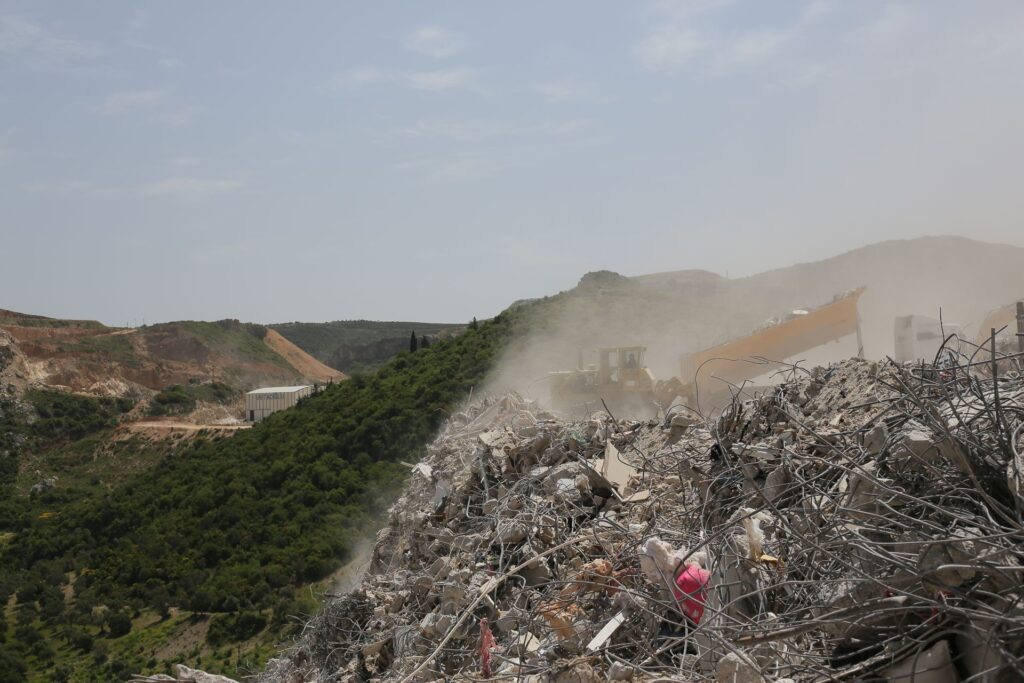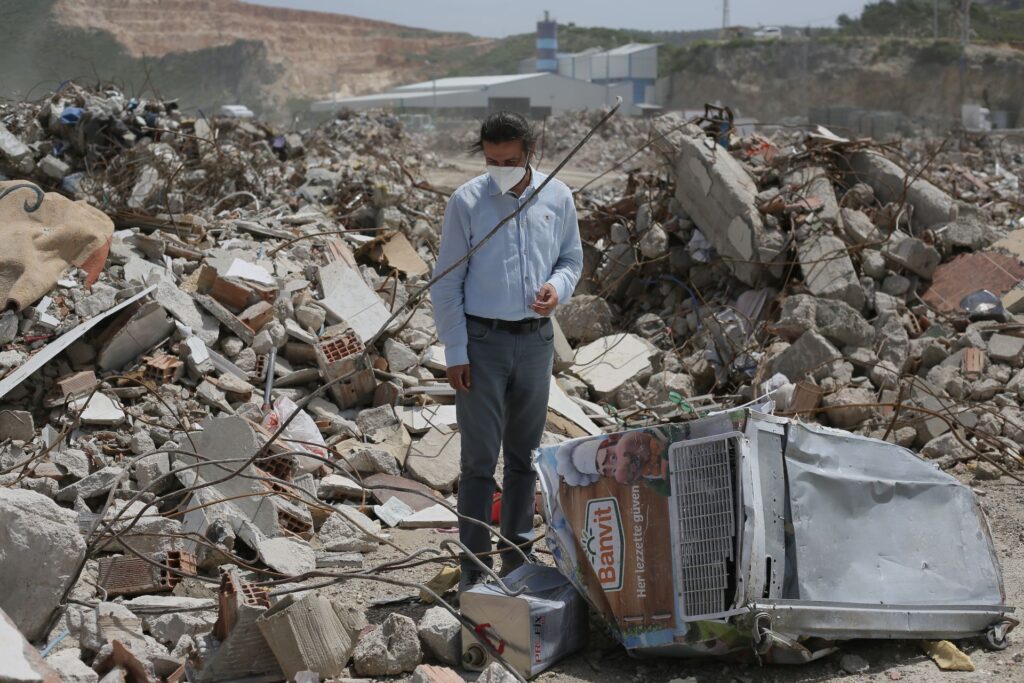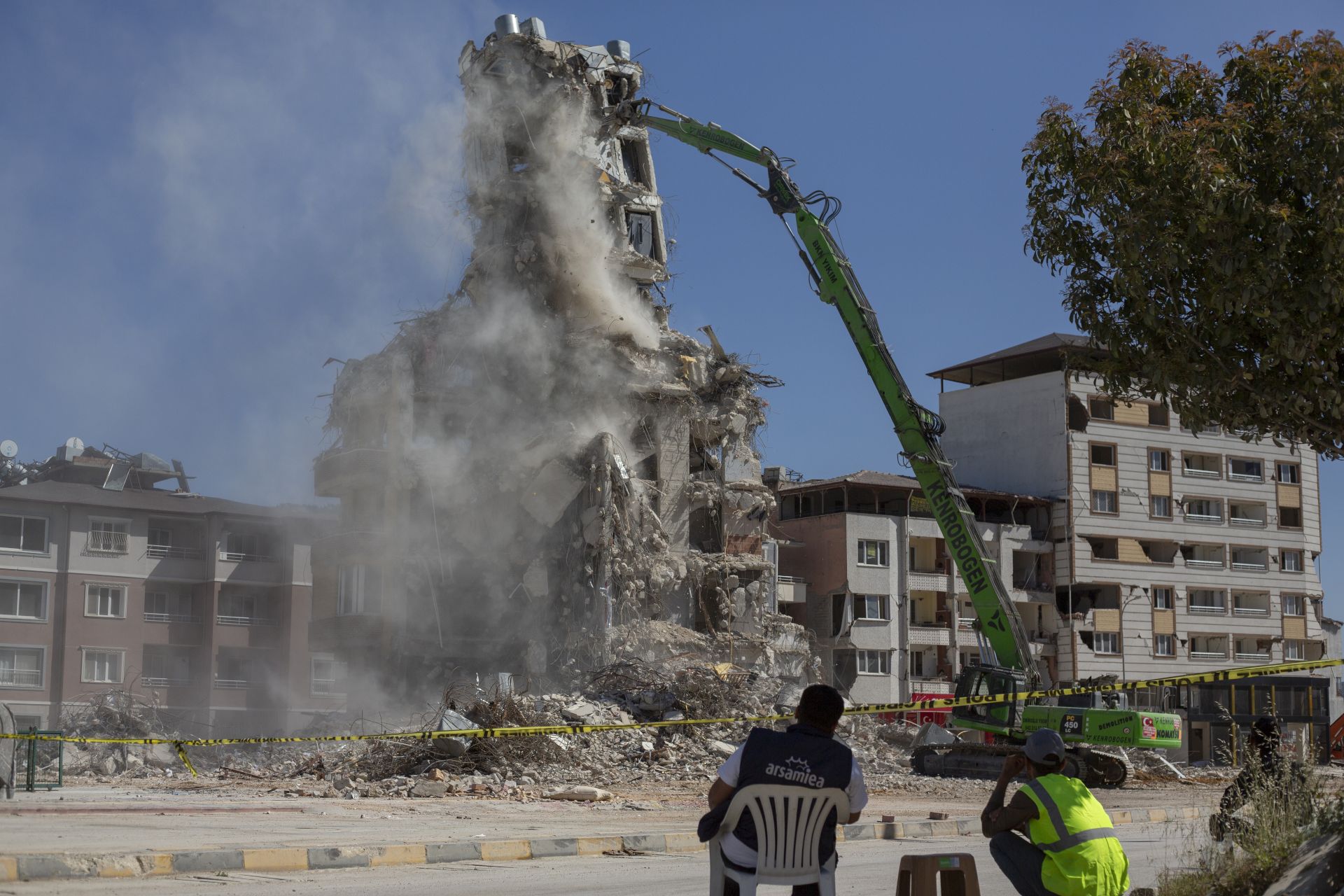From the patio of his home in the village of Kovar, perched on a hill on the outskirts of Antakya, the lawyer Ecevit Alkan looks at the skyline of the city he used to live in before twin earthquakes five months ago left most of it in ruins and triggered an exodus of its surviving residents.
Dust blurs the contours of the mostly empty buildings, while powdering the collapsed homes’ exposed rebar, the tents of survivors scattered across the city and, most poignantly, the residents’ lungs.
“Look, can you see there is dust over the city right now?” Alkan says, pointing at the foggy Antakya skyline on an otherwise clear day. He asks the question not as if doubting what his own eyes are seeing, but rather to be sure that everyone else can see what he sees.
“And they only finished 10% of what they have to demolish,” he says. It is May, just before the election that will confirm Recep Tayyip Erdogan as Turkey’s president for another five years. “They want to show that they are doing things quickly,” he adds.
The twin earthquakes that devastated southeast Turkey and northwest Syria on Feb. 6 left behind a trail of death, the scale of which remains uncertain. More than 50,000 have been confirmed lost in Turkey alone, while in Syria the official count stands at more than 8,000. An unknown number, likely in the thousands, are still missing.
After it faced backlash for the initial lackluster response to the crisis, the Turkish government wants to project an image of speed and efficiency in the recovery and reconstruction process. But in Hatay, the worst-affected region in Turkey, environmental and civil society groups are concerned that many more could die years down the line because of toxic substances contained in the waste created by tens of thousands of collapsed buildings. They have been gathering evidence that the debris is being disposed of without following the correct procedures, endangering citizens’ health as well as poisoning the environment.
Approximately 280,000 buildings across 11 provinces in southern Turkey collapsed or were severely damaged after the earthquakes. According to U.N. estimates, they could produce up to 210 million tons of rubble in Turkey alone — equivalent to 14,000 soccer fields of debris piled 3 feet high. The last large-scale earthquake in Turkey, in the Marmara region, generated 13 million tons.
Yellow trucks carrying rubble from the destroyed buildings are a ubiquitous sight on highways across the region, carrying anything that couldn’t be salvaged from the ruins — including the remains of those who were never found.
Massive dump sites have appeared near camps and agricultural areas, prompting some residents to take to the streets in protest.
Others, however, see this as proof that Erdogan has kept to his promise to rebuild the earthquake area within a year. Despite widespread anger at the emergency response, people in the earthquake region largely voted as they had before. With the help of carefully crafted media campaigns, they eventually found ways to redirect their anger toward local administrations and ruthless contractors.
Turkey faces a challenge of epic proportions in clearing the disaster waste and rebuilding. Japan’s 2011 earthquake and tsunami, which killed at least 20,000 people, produced 28 million tons of disaster waste, compared with Turkey’s 210 million tons. For Japan, this was the equivalent of about 70% of the total domestic waste the country generates in a regular year. Ten years later, more than 1,000 people still lived in temporary accommodation, despite costly reconstruction efforts.
While Japan contended with the nuclear waste from the Fukushima reactor, some residents and civil society groups in Hatay fear the hastily cleared ruins could now unleash another disaster on survivors and the environment — further increasing the death toll from the catastrophe years down the line.
In April, the Turkish Bar Association of Hatay (of which Alkan is a member), alongside the Chamber of Environmental Engineers, the Turkish Medical Association and other civil society groups from the region, filed a petition to immediately halt the process of clearing the rubble and demolishing buildings as a “precautionary” measure.
The group documented how rubble from collapsed or urgently demolished buildings was being disposed of at 16 sites in Hatay and argued that it constituted a danger to people’s health because of the presence of hazardous materials in the ruins.
“In the literature, they call this wild storage,” explains Alkan, who stayed behind while his wife and 13-year-old daughter moved to the capital, Ankara, to allow the child to continue her schooling.
“All kinds of chemical and biological substances are piled on top of each other,” he says. “We are concerned about asbestos contaminating the air and water.”
After his home in Antakya was severely damaged, Alkan sought refuge with his parents in their village, where their two-story home emerged from the earthquake nearly unscathed. His office in the city, where the remaining buildings largely stand empty, also was forced to shut down. But Alkan is among those in Hatay who stayed behind to put up a fight for the ruined city, which was devastated first by construction that evaded existing regulations and, now, he says, by uncontrolled waste disposal.
From the town of Narlica, the giant pile of earthquake waste looks like a tsunami about to swallow up an entire hill, as well as the olive groves along its flank.
At the top of the hill, the rumble of trucks and bulldozers is constant. The vast majority uncovered, the trucks enter the waste site at regular intervals and dump their cargo of debris, rotting mattresses, rusting pots, children’s toys, human bones and the memories of thousands of people. They tumble down the hill, raising a cloud of white dust and finding their final resting place in the shade of an olive tree.

That cloud, says Alkan, is toxic.
“There is everything here, from food leftovers to chemical waste,” says Alkan as he points to a freezer unit and a large oil tin at the dumpsite.
According to the government’s own waste management regulations, any waste transported to a different location should be covered, and hazardous waste should be disposed of separately. But a Feb. 24 decree exempted these sites from the rules.
“Security measures should have been taken; the perimeter should have been cleared,” Alkan adds as a truck empties another load, raising a cloud of dust that rebounds back to the workers at the site. No one is wearing a protective mask.
“On most days, actually, the wind blows in the other direction toward the town,” says Alkan, pointing at Narlica below.

While studies have shown that inhaling dust can in itself be harmful, local experts are especially concerned about hazardous materials and say that authorities have failed to take the due precautions to limit their spread.
“First of all, the main problem is that this is no ordinary debris,” says Medet Guney, an asbestos disposal expert at the Istanbul Chamber of Environmental Engineers. “We can’t call it debris because it doesn’t contain only cement and other construction waste, it contains everything.”
In an ordinary demolition, he explains, contractors would be asked to eliminate some of the materials — such as furniture, plastics, heavy metals and chemicals — from the building before proceeding to demolish it. It is also important to spray water onto the building to prevent dust from spreading. While this was taking place in some cases, according to videos posted by officials online, locals say it wasn’t systematic. New Lines has witnessed at least one controlled demolition in Antakya where no water was used at all.
New Lines sought comment from the Ministry of Environment, Urbanization and Climate Change as well as Turkey’s disaster management agency, AFAD. Neither had responded to inquiries by the time of publication.
“The problem we have in Hatay is that residential areas are very close to each other, there is a village or neighborhood every 2 to 3 kilometers,” says Luftu Savas, the mayor of Hatay Metropolitan Municipality. “I think rather than where the material is dumped, it’s important to know the process, how this will be done, how long it will take.”
“The only material that was separated at source was steel, and this is because it is profitable,” Guney says.
Among the concerns, says Guney, is the exposure of survivors to asbestos — a mineral that was once used in construction materials including flooring, insulation and roofing, and is now banned in most countries. In Turkey, the use of asbestos was officially outlawed in 2010.
Asbestos is not dangerous if left alone but can be highly carcinogenic when its fibers, which are very hard to break down, are breathed in. For this reason, asbestos is particularly dangerous when the material is disturbed.
The International Agency for Research on Cancer has found sufficient evidence that asbestos is the main cause of mesothelioma — an incurable cancer that affects the thin membranes that line the chest and abdomen — and that it can cause cancers of the lungs, larynx and ovaries. It can also cause asbestosis, a severe inflammation of the lungs, and other nonmalignant disorders. The dose and duration of asbestos exposure affect the level of risk, and symptoms may not appear until decades later. In the United Kingdom, 5,000 people still die of asbestos-related diseases every year, making it more lethal than road accidents there.
In early June, the Chamber of Environmental Engineers used donations from the general public to publish a report on the presence of asbestos across four sites in Hatay, including the dumpsite in Narlica and the city center of Antakya. Asbestos was detected in all four sites surveyed.
In a tweet in response to the report, former Deputy Minister of the Environment, Urbanization and Climate Change Mehmet Emin Birpinar responded that the use of asbestos in materials such as Eternit roofing is “expected,” given that there was no ban on the material before 2010.
“As is known, asbestos is a dangerous substance when it mixes with the air and is inhaled, and we have determined that there is no asbestos in the air in our studies with the Ministry of Labor on this subject,” the minister wrote. It’s not clear whether the study referred to was published, and Birpinar no longer works at the ministry after the elections brought a cabinet reshuffle.
Guney points out that, as per World Health Organization guidelines, asbestos exposure can be determined by counting and studying its fibers after samples are collected from a specific at-risk environment.
“For asbestos, the methodology we use is to measure exposure, which occurs after exceeding a certain limit,” Guney explains.
Back at the site, retired civil servant Mustafa Dedi emerges from one of the bulldozers leveling the landfill area.
He says he works at the site on a temporary basis for just the minimum wage, in order to pay for his retirement, though he says he is happy with the financial arrangement. Just like a dozen other workers at the site, he’s not wearing a mask.
“Nobody has given us any masks,” he explains.
The wind in the eastern Mediterranean town of Samandag, south of Antakya, is often so strong it makes it difficult to sustain a conversation. But today, at least, it is not blowing dust from the three-story mound of earthquake waste directly onto the camp for displaced people that has been set up in the city’s main stadium, just across the road from the rubble. Here, too, the hustle and bustle of lorries is constant. Winds carry the dust toward a long and picturesque stretch of dark-sanded beach nearby.
In the camp, Alkan distributes FFP3 masks to children playing in a small clearing among the tents, and hands them out in batches to elderly people sitting under the shade of a canopy, drinking tea.
“When the wind blows in this direction, we all hide in the tents,” explains Yeliz Bagdat, 46, as she strokes the hair of her 12-year-old daughter, pointing to a layer of black dirt that encrusts one side of the white tents. About 200 people are currently living in the camp.
“The rubble started coming soon after we arrived,” she adds. “It is not good for the kids. Some have eye problems, others throw up, others have diarrhea. There is a lot of coughing as well from the dust.”
After a disaster, waste is normally brought to temporary storage sites before being recycled.
“You have to distinguish and separate hazardous waste,” says Misuzu Asari, a professor at the School of Global Environment at Kyoto University in Japan, who was part of a team that developed guidelines for disaster waste management after the 2011 earthquake.
“That includes asbestos, heavy metals and sometimes organic waste, which have to be stored in special places, away from households or camps,” she adds. “This kind of triage to distinguish the hazardous waste is very important. It’s not only about the amount, but also the quality of the waste.”
Japan followed a three-year plan to treat the waste, which in normal circumstances would have taken more than a decade. The country was eventually able to recycle nearly 90% of the waste from some prefectures.
But according to Guney, the environmental engineer, the sheer size of these sites will make it very difficult and dangerous to move the waste again.
“To take all the waste from this place to another territory will create some other problems,” he says: “First of all, a problem with dust. And second, it’s costly.”
“I don’t think they will ever move the rubble,” Yeliz says. “They promised to move us from here but we don’t know when,” she adds, raising the pitch of her voice, drowned by the wind.
“We have complained,” says her sister Senay, who is worried about the well-being of her 7-year-old twins. “But so far, nothing has changed.”
Sign up to our mailing list to receive our stories in your inbox.



